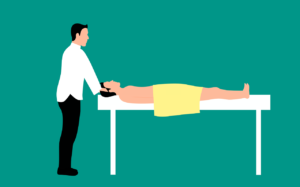
Having neck and shoulder pain when you sleep can be incredibly uncomfortable and disruptive to your rest. In this article, we will explore some effective strategies to help you find relief from this common issue. Whether it’s caused by poor sleeping posture, an unsupportive mattress, or tension built up during the day, we have tips and techniques that will help alleviate your discomfort and ensure a better night’s sleep. Say goodbye to those frustrating mornings with a sore neck and shoulders, and say hello to a peaceful and pain-free slumber.

Causes of Neck and Shoulder Pain When Sleeping
Poor sleeping posture
One of the primary causes of neck and shoulder pain when sleeping is poor sleeping posture. When you sleep in positions that put strain on your neck and shoulders, it can lead to discomfort and pain. For example, sleeping with your neck and head in an awkward angle can result in muscle tension and soreness.
Inadequate support from pillows and mattresses
Another common culprit behind neck and shoulder pain when sleeping is the lack of proper support from your pillows and mattress. If your pillow is too flat or lacks neck support, it can cause your neck to be misaligned during sleep, leading to pain and stiffness. Similarly, a worn-out or unsupportive mattress can affect your spinal alignment and result in discomfort.
Muscle tension and strain
Muscle tension and strain can contribute to neck and shoulder pain when sleeping. This can occur due to various factors such as stress, overuse, or poor posture during the day. When your muscles are tense and tight, it can be difficult to find a comfortable sleeping position, leading to pain and discomfort throughout the night.
Sleeping on the stomach
Sleeping on your stomach is a common habit for many, but it can be a cause of neck and shoulder pain. When you sleep on your stomach, your neck and spine are in an unnatural position, which can strain the muscles and result in pain. Additionally, this sleeping position can also put pressure on your internal organs, causing further discomfort.
Underlying medical conditions
In some cases, neck and shoulder pain when sleeping can be attributed to underlying medical conditions. Conditions such as arthritis, herniated discs, or fibromyalgia can cause chronic pain, including pain that worsens during sleep. It is essential to consult with a healthcare professional if you suspect that an underlying medical condition may be contributing to your discomfort.
Importance of Proper Sleep Positioning
Promotes spinal alignment
One of the key benefits of proper sleep positioning is promoting spinal alignment. When your spine is properly aligned during sleep, it helps to alleviate strain and pressure on your neck and shoulder muscles. This can reduce the likelihood of experiencing pain and discomfort when waking up.
Reduces stress on neck and shoulder muscles
Proper sleep positioning also plays a crucial role in reducing stress on your neck and shoulder muscles. By sleeping in positions that provide adequate support and alignment, you can help prevent tension and strain on these muscles. This, in turn, can contribute to a more relaxed and pain-free sleep.
Enhances blood circulation
Sleep positioning can also impact blood circulation. When you sleep in positions that allow for proper alignment and reduce pressure on your neck and shoulder muscles, it improves the blood flow to these areas. Improved blood circulation can help reduce inflammation and promote healing, reducing pain and discomfort.
Improves sleep quality
Lastly, proper sleep positioning can significantly improve sleep quality. When you are comfortable and free from pain, you are more likely to enter deep, restorative sleep patterns. This can lead to waking up feeling refreshed and rejuvenated, without the nagging neck and shoulder pain that disrupts your sleep.

Choosing the Right Pillow for Neck and Shoulder Pain
Consider your preferred sleep position
When selecting a pillow for neck and shoulder pain relief, it is essential to consider your preferred sleep position. Different sleep positions require different types of pillows to provide adequate support. For example, if you sleep on your back, a pillow with medium firmness and contouring support for the neck would be ideal. If you sleep on your side, a firmer pillow with greater thickness to fill the space between your shoulder and neck would be beneficial.
Opt for pillows with proper neck support
To alleviate neck and shoulder pain, it is crucial to choose pillows with proper neck support. Look for pillows specifically designed to maintain the natural curvature of the cervical spine. These pillows typically have a contour or dip in the middle to cradle your neck and provide optimal support. Memory foam pillows or orthopedic pillows are popular choices for neck support.
Choose the right pillow height
Pillow height is another crucial factor to consider when selecting a pillow for neck and shoulder pain. The height of your pillow should align with the natural curvature of your neck and keep your head in a neutral position. A pillow that is too high or too low can strain your neck muscles and exacerbate pain. Adjusting the pillow height can bring relief and ensure proper spinal alignment.
Experiment with different pillow materials
There are various pillow materials available, each with its own set of benefits. Memory foam pillows conform to the shape of your head and neck, providing customized support and reducing pressure points. Latex pillows are resilient and offer consistent support, while down pillows provide a plush and luxurious feel. It may be helpful to try different pillow materials to determine which one works best for your neck and shoulder pain.
Consider cervical pillows
Cervical pillows are specifically designed to support the natural curve of your neck. These pillows typically have a contour at the bottom to cradle your neck and a flat surface for the head. Cervical pillows can help relieve neck and shoulder pain by providing optimal alignment and support during sleep. Consult with a healthcare professional or pillow specialist to find the right cervical pillow for your needs.
Selecting the Ideal Mattress for Neck and Shoulder Pain
Find the right firmness level
When choosing a mattress to alleviate neck and shoulder pain, finding the right firmness level is crucial. The ideal firmness will depend on your personal preferences and sleep needs. Generally, a medium-firm mattress is a good option as it provides a balance of support and comfort. It allows your body to sink slightly while still maintaining proper spinal alignment.
Consider mattress type (memory foam, latex, innerspring, etc.)
Different mattress types can offer varying levels of support and pressure relief. Memory foam mattresses are known for their contouring properties and ability to relieve pressure points. Latex mattresses are resilient and provide consistent support. Innerspring mattresses offer bounce and firmness. Consider your preferences and needs to determine which mattress type would be most beneficial for your neck and shoulder pain.
Look for pressure-relieving features
To alleviate neck and shoulder pain, look for mattresses with pressure-relieving features. These can include built-in pillow-tops, gel-infused foam layers, or targeted zoning to provide extra support for specific areas of the body. These features can help distribute your body weight more evenly and reduce pressure on your neck and shoulders.
Ensure proper spine alignment
Proper spine alignment is crucial for neck and shoulder pain relief. Look for mattresses that provide adequate support to keep your spine in a neutral position. This means that your head, shoulders, and hips should be aligned, without any excessive sinking or curvature. Maintaining proper spine alignment can alleviate stress on your neck and shoulder muscles and contribute to a pain-free sleep.
Consult with a mattress expert if needed
If you are unsure about selecting the ideal mattress for your neck and shoulder pain, it may be beneficial to consult with a mattress expert. They can provide guidance based on your specific needs and preferences. Testing different mattresses in-store or seeking professional advice online can help you make an informed decision and ensure that you choose a mattress that will provide the necessary support for your neck and shoulder pain.

Sleeping Positions to Alleviate Neck and Shoulder Pain
Sleeping on the back with a supportive pillow
Sleeping on your back is generally considered the best position for neck and shoulder pain relief. Place a supportive pillow under your head that keeps your neck in alignment with your spine. The pillow should provide enough loft to support the natural curve of your neck without lifting your head too high. This position helps distribute your body weight evenly and reduces pressure on your neck and shoulders.
Using a side sleeping position with a pillow between the knees
If you prefer to sleep on your side, it is important to ensure proper spinal alignment. Place a pillow between your knees to keep your hips in alignment and reduce strain on your lower back. Use a supportive pillow that fills the space between your shoulder and neck, maintaining a straight line from your head to your tailbone. This position helps alleviate pressure on your neck and shoulders.
Avoiding sleeping on the stomach
Sleeping on your stomach is not recommended for those with neck and shoulder pain. This position can strain your neck and put pressure on your spine, exacerbating pain and discomfort. If you are used to sleeping on your stomach, try transitioning to a back or side sleeping position for better neck and shoulder support.
Trying the semi-fetal position
The semi-fetal position can be beneficial for neck and shoulder pain relief. Lie on your side with your knees slightly bent, and place a pillow between your legs. This position helps maintain spinal alignment and reduces pressure on your neck and shoulders. Experiment with different pillow placements to find the most comfortable position for you.
Exercises and Stretches for Neck and Shoulder Pain Relief
Neck stretches (side-to-side, up-and-down, rotation)
Neck stretches can help alleviate tension and improve flexibility in your neck and shoulder muscles. Start by gently tilting your head from side to side, bringing your ear towards your shoulder. Then, slowly move your head up and down, looking towards the ceiling and then towards the floor. Finally, rotate your head in a circular motion, ensuring not to force any movements and staying within a comfortable range of motion.
Shoulder rolls and shrugs
Shoulder rolls and shrugs are effective exercises to relieve tightness and improve circulation in your shoulder muscles. Roll your shoulders forward and backward in a circular motion, allowing the tension to release. To perform shoulder shrugs, bring your shoulders up towards your ears and hold for a few seconds before relaxing them down.
Upper back stretches
Stretching your upper back can help relieve tension and pain in your neck and shoulders. Stand with your feet shoulder-width apart and interlace your fingers in front of you. Slowly round your upper back, pressing your hands forward and allowing the stretch to extend between your shoulder blades. Hold the stretch for a few seconds before releasing.
Chin tucks and neck extensions
Chin tucks are an excellent exercise for strengthening the muscles in the front of your neck and improving posture. Stand or sit with your head in a neutral position and gently tuck your chin towards your chest, creating a double chin. Hold this position for a few seconds before releasing. For neck extensions, gently tilt your head back, looking towards the ceiling, and hold for a few seconds. Be cautious not to strain your neck or overextend.
Yoga poses for neck and shoulder pain relief
Yoga offers a wide range of poses that can help relieve neck and shoulder pain. Poses such as Cat-Cow, Child’s Pose, and Thread the Needle can help release tension and improve flexibility in your neck and shoulders. Consult with a yoga instructor or follow online tutorials to learn proper form and technique for these poses.
Heat and Cold Therapy for Neck and Shoulder Pain
Applying heat packs or warm towels
Heat therapy can help relax and soothe the muscles in your neck and shoulders. Apply a heat pack or a warm towel to the affected area for about 15-20 minutes. The heat increases blood flow and promotes muscle relaxation, providing temporary pain relief.
Using ice packs or cold compresses
Cold therapy can help reduce inflammation and numb pain in your neck and shoulders. Place an ice pack or a cold compress wrapped in a thin cloth on the affected area for about 15-20 minutes. Be sure to avoid direct contact with the skin to prevent frostbite. Cold therapy is especially beneficial for acute injuries or inflammation.
Alternating heat and cold therapy
For some individuals, alternating heat and cold therapy can provide additional relief for neck and shoulder pain. Start by applying a heat pack or warm towel for 10 minutes, then switch to a cold pack or cold compress for another 10 minutes. This contrast therapy can help reduce inflammation while promoting muscle relaxation.
Trying heat or cold therapy before sleep
If your neck and shoulder pain are particularly bothersome at bedtime, consider trying heat or cold therapy before sleep. By applying heat or cold therapy to the affected area for 15-20 minutes before bed, you can help alleviate muscle tension and promote a more comfortable sleep.
Creating a Sleep-Conducive Environment
Optimizing bedroom temperature
Maintaining an optimal bedroom temperature can contribute to a better night’s sleep and reduce the risk of neck and shoulder pain. Most people find a temperature between 60-67 degrees Fahrenheit to be the most comfortable for sleep. Experiment with different settings to find what works best for you.
Reducing noise and light disturbances
Noise and light disturbances can disrupt your sleep and impact your overall comfort level. Invest in earplugs or a white noise machine to block out any external noises that may interfere with your sleep. Use blackout curtains or an eye mask to create a dark and peaceful sleep environment.
Choosing comfortable bedding and sleepwear
The type of bedding and sleepwear you choose can significantly impact your comfort level while sleeping. Opt for breathable and lightweight materials that wick away moisture and promote airflow. Choose a mattress topper or a mattress pad that adds an extra layer of cushioning and support.
Eliminating potential allergens and irritants
Allergens and irritants can disrupt your sleep and exacerbate neck and shoulder pain. Keep your bedroom clean and free from dust, pet dander, and allergens that may trigger allergies or respiratory issues. Wash your bedding regularly and use hypoallergenic pillowcases and mattress covers to minimize potential irritants.
Maintaining a clean and clutter-free sleeping area
A clutter-free sleeping area can contribute to peace of mind and better sleep quality. Keep your bedroom tidy and organized, removing any unnecessary items that may contribute to visual or mental clutter. A clean and serene environment can enhance relaxation and alleviate neck and shoulder pain.
Additional Tips for Neck and Shoulder Pain Prevention
Avoiding prolonged sitting and poor posture during the day
Prolonged sitting and poor posture during the day can contribute to neck and shoulder pain. Take frequent breaks to stretch and move around, ensuring proper posture alignment while sitting. Incorporate ergonomics into your workspace to reduce strain on your neck and shoulders.
Using a supportive office chair and ergonomic setup
If you spend a significant amount of time working at a desk, invest in a supportive office chair and set up an ergonomic workstation. Use an adjustable chair that provides proper lumbar support and promotes good posture. Position your computer monitor at eye level to minimize strain on your neck and shoulders.
Engaging in regular physical activity and stretching
Regular physical activity and stretching can help alleviate muscle tension and promote overall health. Engage in exercises that focus on strengthening and stretching the neck and shoulder muscles. Incorporate activities such as walking, swimming, or yoga into your routine to keep your muscles supple and healthy.
Practicing stress reduction techniques
Stress can contribute to muscle tension and exacerbate neck and shoulder pain. Practice stress reduction techniques such as deep breathing exercises, meditation, or mindfulness to promote relaxation and alleviate pain. Find activities that help you unwind and restore balance, such as reading, listening to soothing music, or taking a warm bath.
Seeking professional help if pain persists
If your neck and shoulder pain persist despite trying various self-care measures, it is important to seek professional help. A healthcare professional, such as a physical therapist or chiropractor, can assess your condition and provide targeted treatments and exercises to alleviate your pain. Do not hesitate to reach out for assistance if needed.
Conclusion
Neck and shoulder pain when sleeping can significantly disrupt your sleep quality and overall well-being. By addressing the causes of pain and implementing proper sleep positioning, using supportive pillows and mattresses, and engaging in exercises and stretches, you can alleviate discomfort and promote a restful night’s sleep. Additionally, incorporating heat and cold therapy, creating a sleep-conducive environment, and adopting preventive measures can further contribute to neck and shoulder pain relief. Remember to consult with healthcare professionals if your pain persists or intensifies, as they can provide personalized guidance and treatment options. With the right approach, you can wake up refreshed and pain-free, ready to tackle the day ahead.







